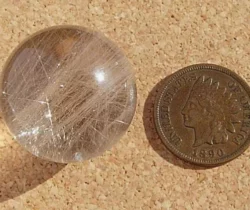Habits are the distinctive form that mineral crystals may take in different geologic settings. It refers to the differences in form when they grow in a free space compared to growing in a particular environment, for example.
Acicular Habit
:max_bytes(150000):strip_icc():format(webp)/acicular-58b5a6a75f9b58604697e3d9.jpg)
A habit can be a strong clue to a mineral’s identity. Here are examples of some of the most useful mineral habits. Note that “habit” also has a meaning for rocks.
Acicular means “needlelike.” This mineral is actinolite.
Amygdaloidal Habit
:max_bytes(150000):strip_icc():format(webp)/amygdaloidal-58b5a7495f9b58604699ddac.jpg)
Amygdaloidal means almond-shaped, but it refers to the former gas bubbles in lava called amygdules, which are cavities that have become filled with various minerals.
Banded Habit
:max_bytes(150000):strip_icc():format(webp)/banded-58b59da23df78cdcd87537b3.jpg)
“Banded” is a broadly layered texture. This rhodochrosite specimen might be called stalactitic, lamellar, geode, or concentric if it were curved differently.
Bladed Habit
:max_bytes(150000):strip_icc():format(webp)/bladed-58b5a73c3df78cdcd88a5bbe.jpg)
Bladed crystals are longer and thinner than tabular crystals but stubbier than acicular crystals. Kyanite is a common example. In rock shops, look for stibnite.
Blocky Habit
:max_bytes(150000):strip_icc():format(webp)/blocky-58b5a7345f9b586046999e30.jpg)
A blocky habit is squarer than equant and shorter than prismatic. This mineral is pyrite on quartz.
Botryoidal Habit
:max_bytes(150000):strip_icc():format(webp)/botryoidal-58b5a72d5f9b586046998832.jpg)
In scientific Latin, botryoidal means “like grapes.” Carbonate, sulfate, and iron oxide minerals tend to have this habit. This specimen is barite.
Cruciform Habit
:max_bytes(150000):strip_icc():format(webp)/cruciform-58b5a7273df78cdcd88a1b1a.jpg)
The cruciform (cross-shaped) habit is the result of twinning. Staurolite, shown here, is well known for favoring this habit.
Dendritic Habit
:max_bytes(150000):strip_icc():format(webp)/dendritic-58b5a71f3df78cdcd88a04ae.jpg)
Dendritic means “like branches.” It can refer to flat crystals, like those of manganese oxides, or three-dimensional forms like this specimen of native copper.
Drusy Habit
:max_bytes(150000):strip_icc():format(webp)/drusy-58b5a7183df78cdcd889eebe.jpg)
Druses are a type of opening inside rocks that are lined with projecting crystals. Amethyst, cut from geodes, is commonly sold in rock shops for its pretty drusy habit.
Encrusting Habit
:max_bytes(150000):strip_icc():format(webp)/encrusting-58b5a7143df78cdcd889e186.jpg)
Calcite, the main component of limestone, commonly dissolves to be deposited elsewhere as a crust. Chips in this specimen show how it coats the underlying rock.
Equant Habit
:max_bytes(150000):strip_icc():format(webp)/equant-58b5a70f5f9b5860469925a1.jpg)
Crystals of nearly equal dimensions, like these pyrite crystals, are equant. Those on the left might be called blocky. Those on the right are pyritohedrons.
Fibrous Habit
:max_bytes(150000):strip_icc():format(webp)/fibrous-58b5a7083df78cdcd889b931.jpg)
Rutile is typically prismatic, but it can form whiskers as in this rutilated quartz. Curved or bent fibrous minerals are called capillary, or filiform, instead.
Geode Habit
:max_bytes(150000):strip_icc():format(webp)/geode-58b5a6ff5f9b58604698f5ce.jpg)
Geodes are rocks with open cores, or druses, lined with different minerals. Most geodes contain quartz or, as in this case, calcite with a drusy habit.
Granular Habit
:max_bytes(150000):strip_icc():format(webp)/granular-58b5a6f13df78cdcd88974f4.jpg)
If crystals are not well-formed, what might otherwise be called an equant habit is instead called granular. These are spessartine garnet grains in a sandy matrix.
Lamellar Habit
:max_bytes(150000):strip_icc():format(webp)/lamellar-58b5a6e83df78cdcd889579a.jpg)
Lamellae are leaves in scientific Latin, and a lamellar habit is one of the thin layers. This gypsum chunk can readily be pried apart into crystal sheets.
Massive Habit
:max_bytes(150000):strip_icc():format(webp)/massive-58b5a6e15f9b586046989973.jpg)
The quartz in this gneiss boulder has a massive habit, with no individual grains or crystals visible. Caution: rocks may also be described as having a massive habit, too. If you can, use a more appropriate term like equant, granular or blocky to describe them.
Micaceous Habit
:max_bytes(150000):strip_icc():format(webp)/micaceous-58b5a6da5f9b58604698840e.jpg)
Minerals that split into extremely thin sheets have a micaceous habit. Mica is the prime example. This chrysotile specimen from an asbestos mine also has thin sheets.
Platy Habit
:max_bytes(150000):strip_icc():format(webp)/platy-58b5a6d53df78cdcd8891a57.jpg)
A platy habit might be better described as lamellar or tabular in some instances, but this thin sheet of gypsum can be called nothing else.
Prismatic Habit
:max_bytes(150000):strip_icc():format(webp)/prismatic-58b59ed15f9b586046869989.jpg)
Prism-shaped minerals are common in granites. Tourmaline’s nine-faced prisms are distinctive and diagnostic. Very long prisms are called acicular or fibrous.
Radiating Habit
:max_bytes(150000):strip_icc():format(webp)/radiated-58b5a6c55f9b586046983f80.jpg)
This “pyrite dollar” grew from a central point, squeezed flat between shale layers. The radiating habit can have crystals of any form, from blocky to fibrous.
Reniform Habit
:max_bytes(150000):strip_icc():format(webp)/reniform-58b5a6bd3df78cdcd888d052.jpg)
Reniform refers to being kidney-shaped. Hematite displays reniform habit well. The fracture shows that each round mass consists of radiating small crystals.
Rhombohedral Habit
:max_bytes(150000):strip_icc():format(webp)/rhombohedral-58b5a6b55f9b5860469810ac.jpg)
Rhombohedrons are bent cubes in which no corner is straight; that is, each face of this calcite grain is a rhombus, and there are no right angles.
Rosette Habit
:max_bytes(150000):strip_icc():format(webp)/rosette-58b5a6af3df78cdcd888a7ad.jpg)
Rosettes are groups of tabular or bladed crystals arranged around a central point. These barite rosettes are composed of tabular crystals.
CITE THIS ARTICLE
Alden, Andrew. “Definition and Examples of Mineral Habits.” ThoughtCo, Feb. 16, 2021, thoughtco.com/all-about-mineral-habits-4122987.




